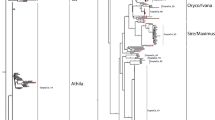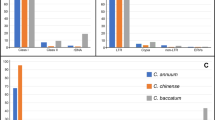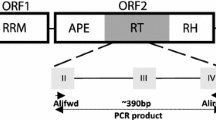Abstract
A large portion of plant and particularly cereal genomes consist of repetitive DNA families, many of which are likely to be or to have evolved from retroelements. Molecular evidence suggests that repeated DNA sequences, although perhaps originating as innocuous or ‘selfish’ elements, can have dramatic effects on genome organization and function. Knowledge of chromosomal distribution of retroelements is important for understanding plant chromosome structure/functional organization, and could shed light on the dynamics of retroelements and their role in the evolutionary process. In the present study we aim to find a possible correlation between physical location of the regions with species-specific sequences and the distribution of conserved RT domains of the Ty1-copia, Ty3-gypsy and LINE groups of retroelements on the chromosomes of two diploid species that belong to the different branches of the tribe Triticeae, namely Aegilops speltoides Tausch (2n=2x=14) and Hordeum spontaneum L (2n=2x=14). All three groups of retroelements were found in large quantities in the genomes of the tested species. They are cluster-distributed, and the important role of these elements in the formation of terminal heterochromatin is shown. We found that there was a predominance of Ty1-copia and LINE elements in the chromosome regions with preferential content of species-specific sequences.
Similar content being viewed by others
References
Badaeva ED, Friebe B, Gill BS (1996) Genome differentiation in Aegilops. 2. Physical mapping of 5S and 18S 26S ribosomal RNA gene families in diploid species. Genome 39: 115–1158.
Belyayev A, Raskina O (1998) Heterochromatin discrimination in Aegilops speltoides by simultaneous genomic in-situ hybridization. Chromosome Res 6: 55–565.
Belyayev A, Raskina O, Korol A, Nevo E (2000) Coevolution of A and B-genomes in allotetraploid Triticum dicoccoides. Genome 43: 102–1026.
Bennetzen JL (1996) The contribution of retroelements to plant genome organization, function and evolution. Trends Microbiol 4: 34–353.
Bernardi G (1989) The isochore organization of human gen-ome. Annu Rev Genet 23: 63–661.
Brandes A, Heslop-Harrison JS, Kamm A, Doudrick RL, Schmidt T (1997) Comparative analysis of the chromosomal and genomic organization of Ty1–copia like retrotransposons in pteridophytes, gymnosperms and angiosperms. Plant Mol Biol 33: 1–21.
Grandbastien M-A (1992) Retroelements in higher plants. Trends Genet 8: 10–108.
Heslop-Harrison JS, Brandes A, Taketa S et al. (1997) The chromosomal distribution of Ty1–copia group retrotranspos-able elements in higher plants and their implication for genome evolution. Genetica 100: 19–204.
Kalendar R, Tanskanen J, Immonen S, Nevo E, Schulman AH (2000) Genome evolution of wild barley (Hordeum spontaneum) by BARE-1 retrotransposon dynamics in response to sharp microclimatic divergence. Proc Natl Acad Sci USA 97: 660–6607.
Kidwell KK, Osborn TC (1992) Simple plant DNA isolation procedures. In: Beckmann JS, Osborn TC, eds. Plant Genomes: Methods for Genetic and Physical Mapping. Dordrecht: Kluwer Academic Publishers, pp 1-13.
Kubis SE, Heslop-Harrison JS, Desel C, Schmidt T (1998) The genomic organization of non-LTR retrotransposons (LINEs) from three Beta species and ¢ve other angiosperms. Plant Mol Biol 36: 82–831.
Kumar A, Bennetzen JL (1999) Plant retrotransposons. Annu Rev Genet 33: 47–532.
Moore G, Cheung W, Schwarzacher T, Flavell R (1991) BIS 1, a major component of the cereal genome and a tool for study-ing genomic organization. Genomics 10: 46–476.
Presting GG, Malysheva L, Fuchs J, Schubert I (1998) A Ty3/Ty3–gypsy retrotransposon-like sequence localizes to the centromeric regions of cereal chromosomes. Plant J 16: 72–728.
Purugganan MD, Wessler SR (1994) Molecular evolution of magellan, a maize Ty3/Ty3–gypsy-like retrotransposon. Proc Natl Acad Sci USA 91: 1167–11678.
SanMiguel P, Tikhonov A, Jin Y-K et al. (1996) Nested retrotransposons in the intergenic regions of the maize gen-ome. Science 274: 76–768.
Schmidt T, Kubis S, Heslop-Harrison JS (1995) Analysis and chromosomal localization of retrotransposons in sugar beet (Beta vulgaris L.): LINEs and Ty1–copia-like elements as major components of the genome. Chromosome Res 3: 33–345.
Schweizer D (1980) Fluorescent chromosome banding in plants: applications, mechanisms, and implications for chromosome structure. In: Davies DR, Hopwood RA, eds. Proc. 4th John Innes Symposium. Norwich 1979: The Plant Genome. Norwich: John Innes Charity, pp 6–72.
Suoniemi A, Anamthawat-Jo¨ nsson K, Arna T, Schulman AH (1996) Retrotransposon BARE-1 is a major, dispersed component of the barley (Hordeum vulgare L.) genome. Plant Mol Biol 30: 132–1329.
Taketa S, Ando H, Takeda K, Harrison GE, Heslop-Harrison JS (2000) The distribution, organization and evolution of two abundant and widespread repetitive DNA sequences in the genus Hordeum. Theor Appl Genet 100: 16–176.
VanderWiel PL, Voytas DF, Wendel JF (1993) Ty1–copia-like retrotransposable element evolution in diploid and polyploid cotton (Gossypium L.). J Mol Evol 36: 42–447.
Von Strenberg RM, Novick GE, Gao G-P, Herrera RJ (1993) Genome canalization: the coevolution of transposable and interspersed repetitive elements with single copy DNA. In: McDonald JF, ed. Transposable Elements and Evolution. Dordrecht: Kluwer Academic Publishers, pp 10–139.
Voytas DF (1996) Retroelements in genome organization. Science 274: 73–738.
Xiong Y, Eickbush TH (1990) Origin and evolution of retroelements based upon their reverse transcriptase sequences. EMBO J 9: 335–3362.
Rights and permissions
About this article
Cite this article
Belyayev, A., Raskina, O. & Nevo, E. Chromosomal distribution of reverse transcriptase-containing retroelements in two Triticeae species. Chromosome Res 9, 129–136 (2001). https://doi.org/10.1023/A:1009231019833
Issue Date:
DOI: https://doi.org/10.1023/A:1009231019833




